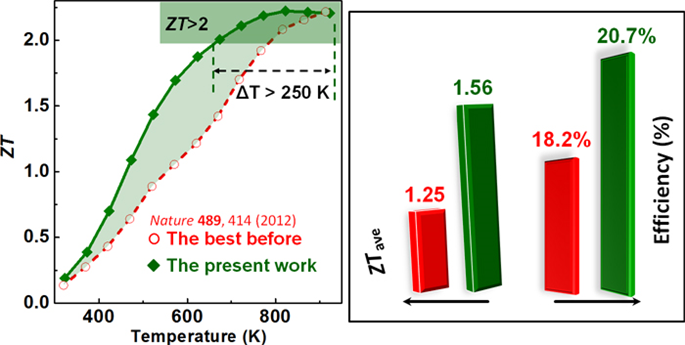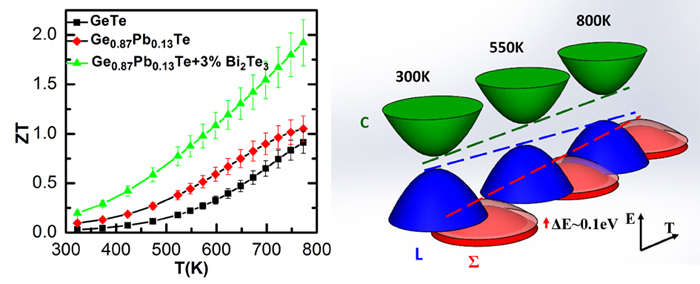When human society sees a rocket-like development, both energy crisis and environmental issues are latent troubles requiring attentions. The global research community has agreed that it is necessary to apply the scientific strength (such as seeking and developing high-efficiency, new energy conversion methods and energy-storage materials) to resolve the dilemma faced by human society in its pursuit of a sustainable development. Researchers are working with unremitting efforts to develop new energy materials for a higher energy-conversion efficiency and enlarge the application scope of these new materials from laboratories to thousands of households.
Professor Jiaqing He, from the Physics Department of the Southern University of Science and Technology and his team have been working on seeking new functional materials and have made significant achievements in functional thermoelectric materials’ structures, physical properties and mechanisms as well as the relevant research fields by making multiple breakthroughs. The laboratory’s heat-to-electricity conversion efficiency they obtained has been twice as efficient as those currently in the market.
Thermoelectric materials are a new-type of functional materials, through which the electric and thermal energy can be interconverted directly. Through the thermoelectric material, the ubiquitous heat sources (such as car exhaust, industrial waste heat, terrestrial heat, etc.) that are present in the natural world and daily life but that are wasted, can be converted to electric power. It offers a new source of energy that is required in people’s daily life and industrial production. Additionally, thermoelectric devices are characterized by small environmental footprints, compact dimensions, lightweight, no mechanical power transmission, no working noise, quick reaction, long service lives, and so on. Thermoelectric materials, with their unique energy-conversion properties and advantages in preparation and application, have attracted interest from researchers world-wide.
It is known that all materials, such as solar photoelectric materials and the materials used in power generation by friction, that are used worldwide, are trapped in the low energy-conversion efficiency. The energy-conversion efficiency of the thermoelectric materials also requires urgent improvement. The energy-conversion efficiency of the thermoelectric devices can be obtained through the following formula:

Where, Th and Tc mean the temperatures at the hot end and cold end respectively, Tave means the average temperature, and Z means the figure of merit (with the unit of T-1). Generally, ZT is considered as a whole and is defined as the dimensionless thermoelectric figure-of-merit for the materials. According to the formula, the devices made from the thermoelectric materials with higher ZT value will certainly have a higher conversion efficiency. The calculation shows that, if the ZT value of the thermoelectric materials is greater than 3, the conversion efficiency of the thermoelectric devices can be on a par with that of Carnot heat engines. Unfortunately, the ZT values of the thermoelectric materials used in most international systems have not been greater than 2. As a result, rising the ZT values of the thermoelectric materials becomes the key factor in the thermoelectric-material research.
In recent years, Professor Jiaqing He and his team have obtained excellent thermoelectric properties by adjusting and controlling the carrier concentrations, energy band structures and microstructures of the potassium-doped PbTe-PbS thermoelectric materials:
When the temperature is 923K, the peak value of ZT reaches 2.2, the temperature plateau of ZT peak value is wide, i.e. ZT value is about 1.56, and the corresponding heat-to-electricity efficiency in the laboratory is as much as 20.7% (as shown in Figure 1). The relevant achievements are detailed in a paper published in Nature Communications (2014, 5, 4515). The materials show extremely low lattice conductivity under the temperature scope of 300~923K, and the research with the advanced electron microscopy has found that the cause of such extremely low lattice conductivity is its extremely complicated microstructures: micron-grade tellurium/lead sulfide grain, micron-grade cubic excluded phase, atomic-scale stratified structure, dislocations, etc. These crystal defects with various scales can effectively scatter acoustic phonons of various wavelengths and further lower the lattice thermal conductivity drastically. Accordingly, the application potential of the materials is great.

Figure 1 Thermoelectric quality factor ZT and energy conversion efficiency
GeTe system is another successful example of the adjusting and controlling of the microstructures and energy band structures. Jiaqing He and his team found that the 3 mol% of Bi-doping can adjust and control the microstructures and energy band structures of Ge1-xPbxTe system and can, further, upgrade its thermoelectric properties (the peak value of ZT is 1.9): as a result, the power is promoted greatly, and the lattice conductivity is effectively lowered. He and his team analyzed deeply and found that the reason why Bi-doping changes the energy band structure of Ge0.87Pb0.13Te is that Bi, the n-type doping, replaces the Ge in the matrix lattice, narrows the band gap between the light valence band near the L point and the heavy valence band near the Σ point in the GeTe Brillouin zone and further improves the overall effective mass of the charge carrier and the effective degeneracy of the energy levels. Professor Jiaqing He proposed a new mechanism in which the Te system’s carrier concentration is lowered due to Bi-doping (Ge, Pb): the “neutral vacancy” introduced by Bi upgrades Pb’s solid solubility and further lowers Ge’s vacancy concentration, effectively decreasing the carrier concentration. The phenomenon that the solid solubility of the dopant grows due to the adding of another dopant is rare. Thus, this research finding can serve as a reference for the relevant material fields (as shown in Figure 2). The relevant results are detailed in JACS (JACS 2014, 136, 11412).

Figure 2 The great improvement of thermoelectric properties caused by Bi-doping is illustrated in terms of energy band structures
At the Southern University of Science and Technology, Jiaqing He and his team do not only work on how to increase the thermoelectric figure of merit of the thermoelectric materials greatly but also try to find out more relevant mechanisms to optimize the thermoelectric materials by virtue of the advanced research conditions provided in the Shenzhen key laboratory for thermoelectric materials and Center for Picoscale Fundamental and Applied Research at Southern University of Science and Technology. In the principles of deepening and refining the scientific researches, Professor He and his team have been trying their best to find out the essentials of the high-efficiency productivity for the thermoelectric materials and have yielded impressive results.
In the pseudo-biphasic system of PbTe-PbS, they provide an unusual and reasonable explanation for the saturation effect of the materials’ electrical properties under high temperature, i.e. the Na+ that is limited in the crystal boundary or phase boundary diffuses to the parent material under high temperature (higher than 600K) and is subject to re-solution, causing the modulation effect for the carrier concentration. These reactions provide a powerful guarantee for the overall thermoelectric properties of the PbTe-PbS pesudo-biphase in the high-temperature zone. The relevant details are published in the EES (Energy & Environ. Sci. 2015, 8, 2056). Other achievements are: the interpretation on the principles of the influence from the nanostructures on the thermoelectric materials’ low thermal conductivity, which is published in Adv. Mater. (Adv. Mater. 2016, 28, 2737); and the interpretation on the extremely low thermal conductivity’s influence on the material properties of polycrystalline SnSe, which is published in Adv. Funct. Mater. (Adv. Funct. Mater., 2016, 26, 6836); researches on the methods of obtaining the low thermal conductivity from BiCuSeO materials, which is published in Nano Energy (Nano Energy, 2016, 27, 167); finding the high-performance cuprous sulfide thermoelectric material with rare earth mixed, which is published in Adv. Energy Mater. (AEM, 2016, 6, 2016, 00607); the direct finding of the non-stoichiometric defects in monocrystal SnSe, which is published in the Nano Energy (Nano Energy, 2017, 35, 321); the finding that the n-type materials will effectively introduce multi-phase nanostructures into the PbTe parent material through the InSb’s compounding and laboratories’ conditions, and the heat and electricity transport properties of the material system will be optimized simultaneously. That is, on one hand, the energy barrier (potential pit) between the nanostructures and the matrix can raise the Seebeck factor through the energy filtering effect and, further, enhance the power factor; on the other hand, the introduction of the multiplex nanophase strengthens the acoustical phonons’ scattering at the interface, which can lower the lattice conductivity and generates extremely high thermoelectric figure of merit. The relevant details can be found in Adv. Mater. (Adv. Mater. 2017, 1703148) and EES (Energy & Environ. Sci.2017, 10, 2030) recently.
People of different generation have their own dreams and have made their own efforts to realize them. Our vision is that human society can be pushed further forward thanks to thermoelectric materials. To realize this vision, we still need to make tremendous efforts. In the future, with thermoelectricity, there may be no fluorine-containing refrigerators, there may be no greenhouse gases produced during our power consumption, and car exhausts and industrial waste gas may serve as our energy sources. A bright future requires not only vision but also efforts. “Now, our company has been settled down in Longgang District, Shenzhen, which marks the realization of the preliminary industrial application of our high-efficiency thermoeletric devices. In the next stage, the close partnership between laboratories and factories and the integration of scientific research with commercial businesses will be implemented. We ardently hope that the achievements of the scientific research can really make our life better! Pragmatism is the profoundest influence that Professor Jiaqing He has exerted on his team.
Proofread By
Photo By